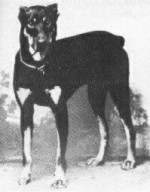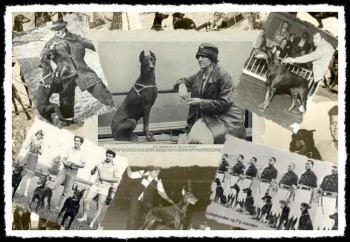DOBERMANN
F.C.I. Standard
Country of Origin:
Use: Companion dog, protection dog and working dog
Classification F.C.I: Group 2: Pinschers and Schnauzers
Short Historical View
The Dobermann breed bears the name of its first known breeder Friedrich Louis Dobermann (January 2nd, 1834 - June 9th,1891). According to tradition, he collected taxes,administered a knacker's yard, and moreover he was municipal dog-catcher legally authorized to catch all straying dogs. From this reservoir he mated especially sharp dogs. The so-called "butchers dogs" surely played the most important role in the formation of the Dobermann breed. Under the circumstances at that time, those dogs can be considered as a relatively homogenious "breed". the dogs were a kind of precursors of today's Rottweilers mixed with a kind of shepard dog with rust-red makings as they used to live in

The Dobermann is a medium-sized, powerful, and muscularly built dog. Because of the elegant lineage of his body, his proud
carriage, his spirited nature and his expression of determination, the dog meets the ideal of a dog.
Important Proportion:
The body of a Dobermann appears almost square this especially applies to males. The length of the body (breastbone to ischium)
shall not exceed the shoulder height by more than 5% (males) and 10% (bitches).
Character:
The basic nature of a Dobermann is friendly and peaceful, very devoted to the family and fond of children. A medium temperament and a medium sharpness are demanded. Furthermore, a medium irritation level is demanded. In addition to the Dobermann's good 'will to obey' (Fuhrigkeit) and "fun to work" (Arbertsfreude), his capability to work, courage, and hardness have to be watched, In addition to alertness towards the environment, special attention has to be played to self-confidence and intrepidity.
Head
Forehead: Strong, suiting the body. Viewed from above, resembling a blunt wedge. Viewed from the front, the crossline of the parting should run almost parallel and should not depress the ears. The parting bone line which extends the bridge of the nose almost straight, depressed slightly toward the neck in a slight curve. The eyebrows are well developed without protruding. The parting furrow is still visible. The occipital bone should not be prominent. Viewed from the front and from above, the side of the upper jaw and the jaw bone must be in harmony with the total length of the head. The muscles of the head are strongly developed.
Stop:
The stop is slightly developed but clearly visible.
Face:
Nose: The tip of the nose is well developed more wide that round with big nostrils, but does not protrude. A black dog must show a black nose, a brown dog's nose shows a lighter colouring.
Muzzle: The muzzle must be strongly developed and in right proportion to the forehead. The muzzle is deep, the corners of the mouth should easily reach the molars. The muzzle must be a good depth also in the area of the upper and lower front teeth.
Lips: The lips lie firm and straight to the jaw and should ensure a tight closing of the corners of the mouth. Dark pigmentation, brown dogs show a little lighter colouring.
Jaws/Dentition/Teeth: Powerful, wide upper and lower jaws. Scissor bit, 42 teeth according the dentition scheme, normal size.
Eyes: They are medium-sized, oval, and of dark colour. A slightly lighter colouring is allowed for brown dogs. Close-fitting eyelids. Eyelids (rims around the eyes) covered with hair.
Ears: The ear is highly placed and carried erect. It is trimmed to a length fitting the head. As some countries prohibit ear trimming, uncropped ears are equally accepted. (A medium - sized ear with its front lying flat at the cheek is desired.)
Neck:
Neck: Of good length in proportion to the body and head. Dry and muscular. The neck line is sloping upwards and pleasingly arched. The posture is erect and shows a lot of nobility.
Body:
Withers: Especially in males, clearly defined in height and length determining the sloping topline to the croup
Back: Short and firm. Of good width and well muscled. Loins of good width and well muscled. Bitches may have slightly longer loins to make room for the breast.
Kruppe : Sie soll vom Kreuzbein in Richtung Rutenansatz gering, also kaum wahrnehmbar abfallen; wirkt somit gut abgerundet, ist weder gerade noch auffällig abfallend. Gute Breite mit starker Muskulatur.
Chest: The length of chest and depth of chest must be in right proportion to the length of the body. The depth of chest with sufficient spring of ribs should approximately reach half the shoulder height. The chest is of good width and especially pronounced to the front (forechest).
Belly Line: From the end of the chestbone to the pelvis the belly is well tucked up.
Tail: The tailset is high. The tail is docked short, two tail vertebras to be left. In countries where tail docking is prohibited by law, the tail can be left natural.
Limbs
Forequarters
In General: When viewed from all sides, the front legs are almost straight, i.e. vertical to the ground. They are powerfully built.
Shoulders: The shoulder blades lie close to the thorax, are well muscled and protrude the spinous processes of the dorsal vertebras. Possibly slanted and well layed back, the aple to the horizontal is approx. 50 degrees.
Elbows: Well close-fitting, not turning out.
Upper arm: Of good length and well muscled. Angle to shoulder blade approx. 105-110 degrees.
Pastern Joint: Strong.
Pasterns: Bones strong; straight when viewed from the front; slightly slopping (not more the 10 degrees) when viewed from the side.
Front Paws: The feet are short and closed. The toes are bent (cat paws); nails short, black.
Hindquarters
In General: When viewed from behind, the Dobermann looks wide and rounded at hips and croup because of his distinct pelvis
muscles. The muscles reaching from the pelvis to the upper and lower shank result in a good wide development of the upper thigh, stifle, and lower thigh. The strong rear legs are straight and parallel.
Upper thigh: Goodlength and width with strong muscles. Good angulation to the hip joint forming an angle to the horizontal of 80-85 degrees.
Stifle: The stifle is strong. It is formed by the upper and lower thigh and the kneecap. The angulation of the stifle is approx. 130
degrees.
Lower Thigh: Of medium length, in harmony with the total length of the hindquarters. Hock Joint: Medium-strong, parallel. The bones of the lower shank and the bone of the hock form the hock joint (angle approx. 140 degrees).
Hock: The hocks are short and stand vertically to the ground.
Hind Paws: As the front paws, the toes of the hind feet are short, bent, and closed. Nails short, black.
Gait
The gait is especially important either for the working ability or for the exterior. The movement is elastic, elegant, nimbly, free, and room-covering with the front legs swinging far forward. The hindquarters striding and springy giving the necessary drive. A front leg and the opposite hind leg move as a pair. Good firmness of the back, ligaments, and joints.
Skin:
The skin is firm all over and well pigmented.
Coat
Texture of coat: The coat is short, hard and thick. It is close-lying and smooth and evenly spread over the whole surface. Undercoat is not allowed.
Colour:
The colour is black or brown, with rust-red, sharply defined, and clean markings. The markings are located at the muzzle, as spots on the cheeks and above the eyebrows, at the throat, two spots on the chest, at the pasterns, hocks, and paws, at the insides of the thighs, at the anus, and ischium.
Height / Weight
Height
Shoulder height: Males: 68-
Medium height desirable.
Weight: Males: approx. 40-
Weight
Males: approx. 40-
Bitches: approx. 32-
Faults
Any deviation from the points mentioned in the standard, should be considered as faults and should be judged in exact proportion to the degree of the deviation.
General appearance: Lack of sex characteristics (Geschlechtsgeprage). Little substance, too light, too heavy, leggy, weak bones.
Head: Too strong, too narrow, too short, too long, too much / too little stop. Roman nose, severely slanting parting bone line, weak pointy underjaw, round or slant eye, light eye, too strong cheeks, lips not lying flat, open or deep-set eye, too high or too low ear set, open or loose lips.
Neck: Slightly short, too short, throatiness, loose skin on the neck, deer neck, too long (unharmonious).
Body: Back not firm, sloping croup, depressed back, roached back, too little or too much rib spring, not sufficient depth and/or width of chest, back overall too long, lack of forechest, too high or too low tail set, belly line too little / too much tucked up.
Limbs: Too little or too much angulation of forequarters and/or hindquarters, loose elbows, position and length of bones and joints deviating from the standard, (front) feet turning in or out, cow-hocked / opposite of cow-hocked (faBbeinig), and narrow stance of hindquarters, open or soft paws, stunted toes, light nails.
Coat: Too light, not sharply defined, unclean (sooty) markings, too dark a mask, big black spots on the feet, hardly visible or too big chest markings. Long, soft, lusterless, and wavy cost as well as thin or hairless spots. Bigger ridges especially on the body, visible undercoat.
Character: Lack of self-confidence, too high temperament, too high sharpness, too low or too high irritation level.
Height: Height deviating from the standard of to
Gait: Wobbly, tripping, unfree movement and pacing.
Disqualifying Faults
In General: Pronounced reversal of sex characteristics (Geschlechtsgeprage).
Eyes: Yellow eyes (eyes colour like eyes of predatory birds), eyes of different colours.
Teeth: Overshot, even bite, undershot, missing teeth.
Coat: White spots, pronounced long-haired or wavy-haired dogs, pronounced thin coat or bigger hairless spots.
Character: Anxious, nervous, and aggressive dogs.
Height: Dogs that show more than
P.S.: Males must have two obviously normally developed testicles in the scrotum.
F.C.I. Standard Nº 143 / February 14th, 1994 / D